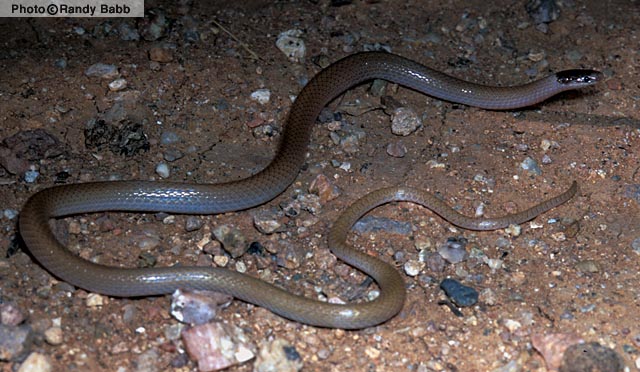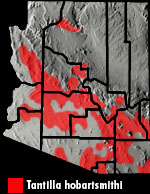Online Field Guide to The Reptiles and Amphibians of Arizona



Maricopa County, AZ
| SMITH’S BLACK-HEADED SNAKE Tantilla hobartsmithi |
Mildly Venomous
|
| DESCRIPTION: A small (up to 313 mm or 12″ in total length), slender, light brown, tan, or gray snake with a dark gray-brown or black head cap. The head cap is straight or slightly convex on its rear edge and extends back only 3 or fewer small scales behind the parietal furrow (central seam between rear-most large head scales). A red, pink, or orange stripe runs down the center of the belly. The scales are smooth and the small head is barely distinct from the neck. There are enlarged, grooved teeth in the rear upper jaw.
DISTRIBUTION: This snake is found across southeastern Arizona and sub-Mogollon Rim central Arizona at elevations ranging from 1,500′ to about 5,500′. HABITAT: It inhabits a variety of biotic communities including Sonoran Desertscrub, Semidesert Grassland, Interior Chaparral, Madrean Evergreen Woodland, and Great Basin Conifer Woodland. It is usually found above the flatlands on rocky bajadas, foothills, mountain canyons and on the higher banks along riparian corridors.BEHAVIOR: This secretive, nocturnal ground-dweller spends the majority of its time beneath the surface of the ground. It is occasionally encountered on the surface at night. Most near-surface activity seems to occur on moist spring days when it is often found under rocks, logs, and surface debris. It hibernates during the cold months of late fall and winter.DIET: Venom is delivered to prey via enlarged, grooved teeth in the rear upper jaw (not considered to be dangerous to humans). It eats a variety of invertebrates including centipedes, scorpions, beetle larvae, and other insects. REPRODUCTION: A clutch of up to 3 eggs is laid in summer. By Thomas C. Brennan Bartlett. 2000. Snakes of North America: Western Brennan, T. C., and A. T. Holycross. 2006. A Field Guide to Amphibians and Reptiles in Arizona. Arizona Game and Fish Department. Phoenix, AZ Brennan, T. C., and A. T. Holycross. 2005. A Field Guide to Amphibians and Reptiles of Maricopa County. Arizona Game and Fish Department. Phoenix, AZ Degenhardt, W. G., Painter, C. W., and Price, A. H.. 1996. Amphibians and Reptiles of New Mexico. University of New Mexico Press. Albuquerque. Fowlie. 1965. The Snakes of Arizona. Azul Quinta Press, Fallbrook, California Stebbins. 1985. Western Reptiles and Amphibians. Houghton Mifflin. New York, |
|
Visit Partners in Amphibian and Reptile Conservation:


HOME
Copyright © 2023, Arizona Game and Fish Department. All rights reserved.
If you make use of the textual contents of this site in reports, publications, etc. please cite and credit the author(s) and photographer(s). All photos on this website are copyrighted. However, those found in the species account section may be used for any noncommercial scientific, educational, or conservation purposes provided that photographs are not altered and continue to bear the copyright symbol and name of the photographer. Please contact the photographer regarding commercial use of copyrighted photographs.










